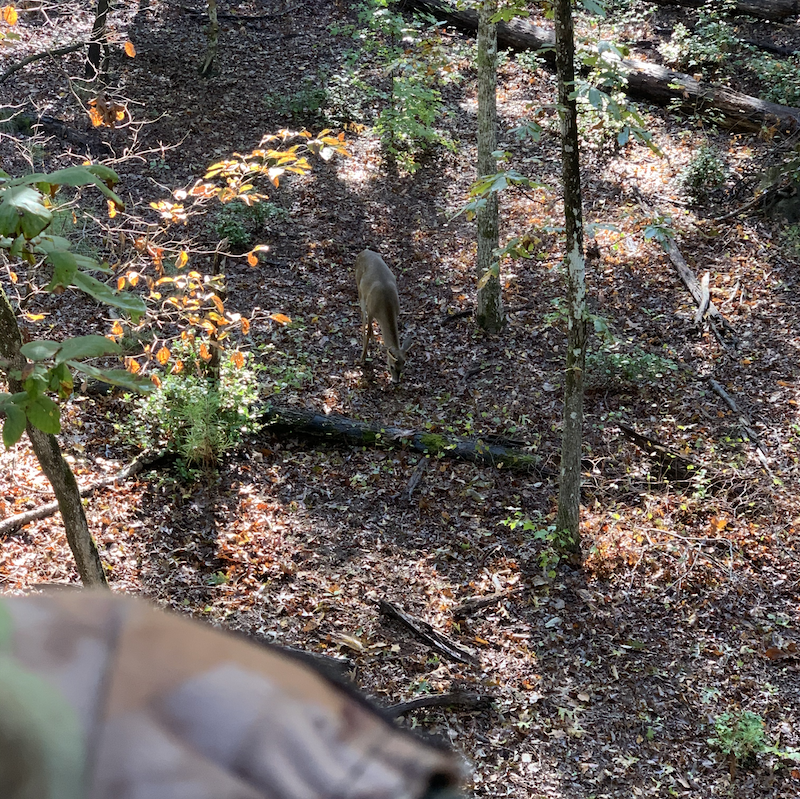The white-tailed deer’s breeding season is a busy time of year for bucks. The so-called rut starts slowly in late summer when the bucks’ new antlers mineralize and harden, prompting bucks to rub away the dying velvet. That practice coincides with decreasing day length (photoperiod) and increasing testosterone levels.
By rubbing their antlers against saplings and brush, bucks remove their velvet while depositing scent on trees and bushes from their preorbital glands (along the eyes), as well as their forehead, nose and saliva. These scent deposits tell other deer “I’m here.”
Bucks also begin sparring about then to establish hierarchies. These matches are mild at first, but as testosterone levels rise in the weeks preceding peak rutting action, the skirmishes can turn into battles that even cause death.

Deer create rubs and scrapes with a greater frequency as rut season nears. Photo Credit: ATA
As breeding activity nears, bucks begin making scrapes, which entails pawing leaf litter and other debris to expose soil. This process can include rub-urinating onto the soil, and squeezing their hind legs together so urine runs down their tarsal glands, leaving their unique scent at the site as their calling card. A scrape almost always includes an overhead licking branch that bucks lick and chew, depositing scent much as they do while creating rubs. Does also visit scrapes and deposit their scent, announcing their presence to would-be suitors.
The timing of the whitetail’s rut varies. Whitetails live from southern Canada to northern portions of South America. The rut’s timing is predictable and consistent from Canada to northern and midwestern portions of the United States, with most breeding occurring during a three-week timeframe from late October to mid-November. That breeding window ensures fawns are born in spring – after the snow melts – when does can find ample food for gestation’s later stages. That schedule also maximizes the fawns’ time to feed and grow before reaching their first winter.
Peak breeding varies more widely in Southern states, where the climate is less severe. Peak breeding times vary widely, typically occurring in August for parts of South Carolina, October in east Texas and southeast Georgia, and into February for parts of Florida. In Central and South America, breeding can take place any time of year.
An article from the Quality Deer Management Association explains more about the rut’s timing.
About 10 days before the first does enter estrus, testosterone-crazed bucks begin seeking receptive does. That’s when you’ll often see bucks out and about any time of day.

Does will also visit scrapes and rubs created by bucks to learn who is in the area. Photo Credit: ATA
Does seem to have at least two breeding strategies. Some stick tight to their core areas. They know these places well, which helps them evade predators. Many does remain inside or near their core areas throughout the rut, assuming wandering bucks will find them. For reasons we might never understand, some does make brief excursions of a half-mile to 3 miles to look for bucks as they go into heat. That strategy might increase genetic fitness by ensuring an influx of different genetics into the herd. After a day or so on their walkabout, does return home.
Mature does enter estrus first. A doe is only in estrus for about 24 hours, but she smells “in heat” to a buck about 24 hours earlier. When a buck crosses the scent of a doe in heat, it tracks her down and stays with her relentlessly, no matter how hard she tries to hide in thick brush or under deadfalls. If rival bucks try to pursue this doe, the buck works hard to drive them away. The doe eventually reaches the peak of her estrous cycle, and lets the buck breed her. Copulation takes place several times during that 24-hour window.
During the peak breeding time, a buck might try to push the doe into an open area or field where it can watch for rival bucks and keep the doe to himself. Once the doe no longer smells right, the buck leaves to find another doe.

Bucks of all ages will get into the rut competition, but does will usually chose bucks with the biggest antlers. Photo Credit: John Hafner
Given the choice, a doe prefers to breed with a large-antlered buck, which means a mature animal. A buck’s physiology prevents it from devoting much energy to its antlers until it reaches its maximum body size at about age 5 or 6. As such, large antlers are true advertisements of fitness. Even so, the first buck to find the receptive doe ends up breeding her because the “king” can’t be everywhere.
Unlike elk, where a dominant bull organizes a harem of cows and tries to breed all of them, many bucks — not just dominant bucks — try to breed does. That’s especially true in herds where does far outnumber bucks. The mature buck simply has too many does to breed, which lets yearling bucks (18 months old) get in on the breeding. In fact, it’s common for one doe to give birth to twin fawns from different sires.
Does that aren’t bred cycle back into estrus about 28 days later. When hunters speak of the “second rut,” they’re talking about the period when does recycle and create a second breeding window, but it’s much more subtle than the peak rut. Still, it can happen, especially in areas with ample food and healthy doe fawns entering their first breeding season. A doe might keep recycling every 28 days until she breeds, but that’s unusual.